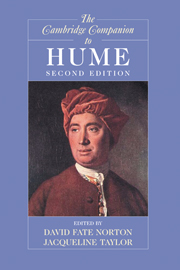Book contents
- Frontmatter
- 1 An Introduction to Hume’s Thought
- 2 Hume’s New Science of the Mind
- 3 Hume and the Mechanics of Mind: Impressions, Ideas, and Association
- 4 Hume’s Theory of Space and Time in Its Skeptical Context
- 5 Hume on Causation
- 6 Hume and the Problem of Personal Identity
- 7 Hume’s Skepticism
- 8 Hume’s Moral Psychology
- 9 The Foundations of Morality in Hume’s Treatise
- 10 Hume’s Later Moral Philosophy
- 11 The Structure of Hume’s Political Theory
- 12 Hume’s Principles of Political Economy
- 13 Hume on the Arts and “The Standard of Taste”: Texts and Contexts
- 14 David Hume: “The Historian”
- 15 Hume on Religion
- Appendix: Hume’s Autobiographies
- Selected Bibliography
- Index
- Series List
11 - The Structure of Hume’s Political Theory
Published online by Cambridge University Press: 28 May 2009
- Frontmatter
- 1 An Introduction to Hume’s Thought
- 2 Hume’s New Science of the Mind
- 3 Hume and the Mechanics of Mind: Impressions, Ideas, and Association
- 4 Hume’s Theory of Space and Time in Its Skeptical Context
- 5 Hume on Causation
- 6 Hume and the Problem of Personal Identity
- 7 Hume’s Skepticism
- 8 Hume’s Moral Psychology
- 9 The Foundations of Morality in Hume’s Treatise
- 10 Hume’s Later Moral Philosophy
- 11 The Structure of Hume’s Political Theory
- 12 Hume’s Principles of Political Economy
- 13 Hume on the Arts and “The Standard of Taste”: Texts and Contexts
- 14 David Hume: “The Historian”
- 15 Hume on Religion
- Appendix: Hume’s Autobiographies
- Selected Bibliography
- Index
- Series List
Summary
David Hume believed that most of the views about society and politics prevalent in his day had roots in one or another of “two species of false religion,” superstition and enthusiasm. Both were developments of conflicting theological doctrines that appealed to two different types of personalities. Both had come to be associated with opposing political interests. Both sprang from ignorance. And, while the two species had been universally present in society and in individuals in varying degrees throughout history, the peculiarity of modern post-Reformation Europe was the violent oscillation between them, as evidenced by them any wars of religion. Their more extreme adherents were also, not least, responsible for the plight of modern Britain, both north and south. One of the tasks of the philosophical historian, Hume believed, was to explain the preponderance at particular times of one or the other of these persuasions. The task he set for his political theory was to explain why both were philosophically misconceived, empirically untenable, and, in their extreme forms, politically dangerous.
THE POLITICS OF RELIGION
One part of humanity, Hume notes, has a tendency to “weakness, fear, [and] melancholy, together with ignorance.” In this state the imagination conjures up forces operating under the surface, and the mind is prone to grasp methods of influencing these forces by “ceremonies, observances, mortifications, sacrifices, presents, or [by] any practice, however absurd or frivolous which either folly or knavery recommends to a blind and terrified credulity.”
- Type
- Chapter
- Information
- The Cambridge Companion to Hume , pp. 341 - 380Publisher: Cambridge University PressPrint publication year: 2008
- 2
- Cited by

